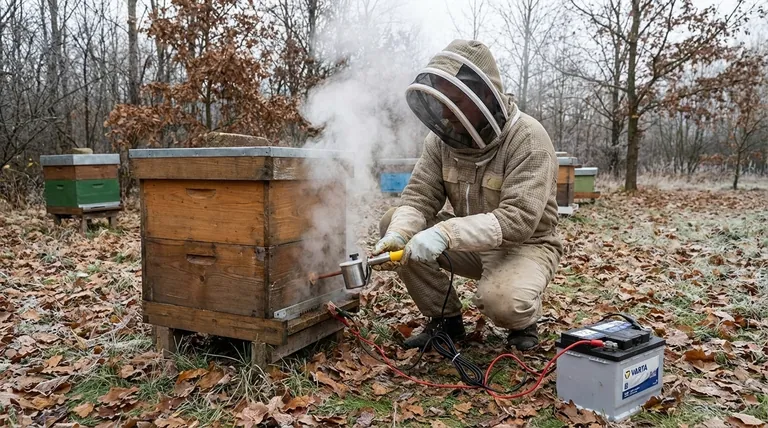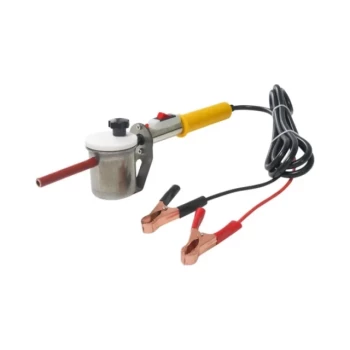The primary goal of a late fall oxalic acid treatment is to dramatically reduce the Varroa mite population in a honey bee colony right before winter. This application is timed to coincide with a period when the queen has stopped laying eggs, making the treatment exceptionally effective and giving the colony its best chance of survival and a strong start the following spring.
The core principle is simple: oxalic acid only kills Varroa mites on the bodies of adult bees, not mites reproducing under the capped cells of brood. By treating in late fall when the colony is "broodless," virtually all mites are exposed and vulnerable, allowing for a highly effective population reset.

Why Late Fall is the Critical Window
To understand the effectiveness of this timing, you must first understand the life cycle of the Varroa mite and how oxalic acid functions as a treatment.
The Varroa Mite's Two Phases
Varroa mites exist in two states within a hive. They are either in a reproductive phase sealed inside a brood cell feeding on a developing bee, or in a phoretic phase, riding on the body of an adult bee.
During the spring and summer when the queen is laying thousands of eggs a day, the majority of the mite population (often 70-80%) is hidden and protected in the reproductive phase.
The "Broodless" Advantage
In late fall or early winter, triggered by colder temperatures and shorter days, the queen naturally stops or dramatically reduces her egg-laying. This results in a "brood break" or a "broodless" period.
Without any sealed brood cells to hide in, nearly 100% of the mite population is forced into the phoretic phase. They are all exposed on the bodies of the adult bees.
How Oxalic Acid Works
Oxalic acid is a contact miticide. It is only effective against the mites it physically touches—those in the phoretic phase. It cannot penetrate the wax cappings of brood cells.
This is why a late fall treatment is so powerful. By applying it when there is no brood, you are targeting the entire mite population at its most vulnerable point.
Choosing Your Application Method
There are two primary methods for applying oxalic acid to a hive in the late fall, each with distinct procedures and considerations.
The Vaporization (Sublimation) Method
This method uses a specialized tool called a vaporizer to heat oxalic acid dihydrate crystals. The crystals turn directly into a gas (sublimate), which fills the hive cavity.
The fine vapor coats the bees and surfaces within the hive, effectively reaching and killing the phoretic mites. This is widely considered the most effective and gentlest method for the bees.
The Dribble (Solution) Method
In this method, oxalic acid is dissolved into a warm sugar syrup solution. The solution is then measured and "dribbled" directly onto the bees between the frames.
While less expensive as it requires no special equipment beyond a syringe, it can be slightly harder on the bees. It is critical to use the correct dosage and not to apply it in temperatures that are too cold, as the moisture can chill the cluster.
Understanding the Trade-offs and Risks
While highly effective, an oxalic acid treatment must be executed correctly to ensure bee safety and efficacy.
Temperature and Timing are Everything
The treatment's success hinges on the colony being broodless. Treating too early, while significant brood is still present, will leave the majority of the mite population unharmed and will render the treatment ineffective.
For the dribble method, the outside temperature should ideally be above 40°F (4.5°C) to prevent chilling the bees with the sugar solution.
Not a Standalone Solution
A late fall oxalic acid treatment is not a complete, year-round mite control plan. It is a specific tool for a specific time.
It should be viewed as the final "knockdown" treatment that cleans up any mites that survived earlier summer treatments, ensuring the winter cluster is as healthy as possible.
Safety is Paramount
Oxalic acid, especially in its vaporized form, is a lung and eye irritant. Always wear the appropriate Personal Protective Equipment (PPE), including a properly rated respirator, safety goggles, and gloves, when handling and applying the treatment.
Applying This to Your Apiary
Choosing the right approach depends on your equipment, budget, and beekeeping philosophy.
- If your primary focus is maximum efficacy and bee safety: The vaporization method is the industry standard for established hives due to its high effectiveness and gentle impact on the colony.
- If your primary focus is low initial cost: The dribble method is a proven alternative, but requires precise measurement and careful attention to application temperature.
- If you are integrating this into a larger plan: Use this treatment as the final "clean-up" after your main summer mite controls have concluded and you have confirmed the colony is broodless.
Ultimately, a well-timed late fall oxalic acid treatment is one of the most important actions a beekeeper can take to ensure their colonies enter winter with a low mite load, setting them up for survival and a productive year ahead.
Summary Table:
| Goal | Key Action | Optimal Timing |
|---|---|---|
| Drastically Reduce Varroa Mites | Apply oxalic acid (vapor or dribble) | Late fall, when the colony is broodless |
| Maximize Treatment Efficacy | Target mites in the phoretic phase (on adult bees) | No sealed brood present to protect mites |
| Ensure Colony Health | Give the winter cluster its best chance of survival | After summer mite controls, before winter clustering |
Equip your apiary for a successful winter. A late fall oxalic acid treatment is a cornerstone of effective Varroa management. HONESTBEE supplies commercial apiaries and beekeeping equipment distributors with the reliable supplies needed for this critical task, including oxalic acid and application equipment. Let us help you protect your investment and ensure strong, healthy colonies for the spring. Contact our wholesale team today to discuss your needs.
Visual Guide

Related Products
- 12V Bee Mite Removal Evaporator Oxalic Acid Vaporizer for Bee Fumigation Treatment 180W Atomization
- Durable 12V Oxalic Acid Vaporizer for Varroa Mite Treatment Beehive Beekeeping Tool
- Oxalic Acid Vaporizer 12V for Bee Varroa Mite Treatment
- Heavy Duty 12V Oxalic Acid Evaporator Vaporizer for Bee Varroa Mite Treatment Beekeeping Fumigator Atomizer
- Adjustable Formic and Acetic Acid Dispenser for Bee Mite Treatment
People Also Ask
- What are the registered application methods for oxalic acid in beekeeping? Choose the Right Varroa Mite Treatment
- Why is oxalic acid not used in summer? Timing is critical for effective Varroa mite control.
- What are the methods of administering oxalic acid against Varroa? Drip vs. Sublimation Explained
- Can oxalic acid vaporization be used with honey supers on the hive? Ensure Legal Compliance & Honey Safety
- What is the role of oxalic acid in plants? A Key to Plant Defense and Internal Regulation



















